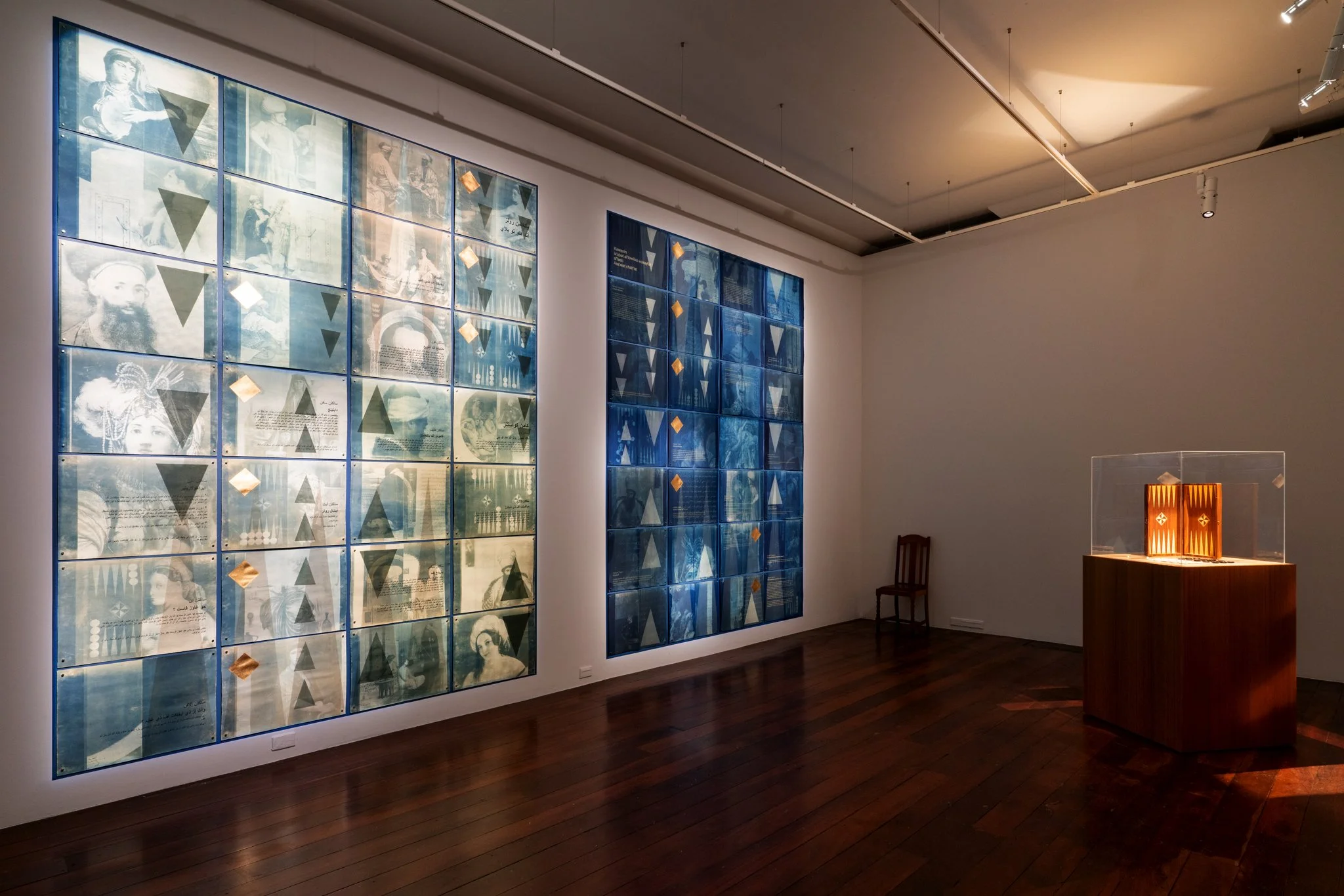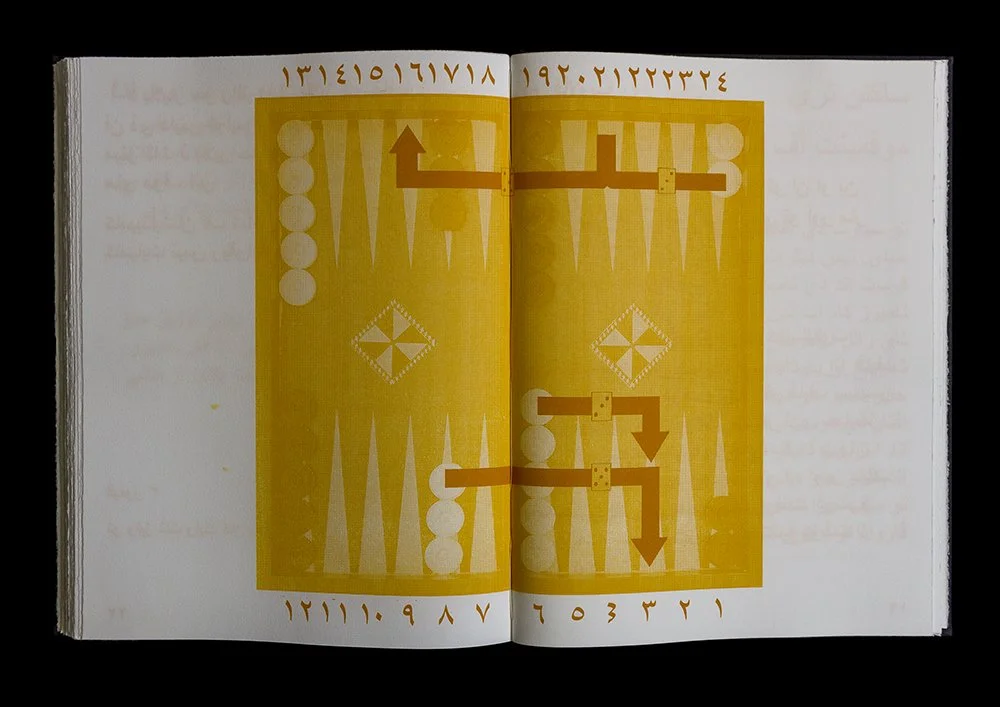The Object of the Game, 2021
Walyalup Fremantle Arts Center, Western Australia
Curated by Andre Lipscombe
Photography: Walyalup Fremantle Arts Centre
Projection Mapped A/V Interactive and Multi-Channel Audio Installation by Steven Alyian
Projection Mapped A/V Interactive and Multi-Channel Audio Installation by Steven Alyian
Exhibition catalogue essay written by Andre Lipscombe
Object of the Game
“I am interested in the place from which we look and construct our understanding of different cultures. Much of my practice concerns the nuanced relationships between East and West. The ways in which these relations are figured and practiced, inform our understandings of self and other. I investigate how such vantages are constructed. The historical context of western notions of the east, characterized by notions of exoticism, romanticism and Orientalism, act as a lens to investigate contemporary representations of the Middle East.”[1]
The ancient board game Towla, known as Backgammon in the West, is the focal point for Deanna Hitti’s enduring project that underpins her printed artworks Towla and Object of the Game (Cultural Transaction series) produced in 2017 and 2021 respectively. Together they are an embodiment of a longstanding investigation of Middle Eastern migrant identity, representation of women in Western Art and cultural knowledge about home and family. Deanna Hitti grew up in a Lebanese/Australian bilingual family, a positive experience, shaped by the observance of Lebanese and Australian customs.
Towla 2017 is a two-colour artist’s book co-written by the artist’s late father, Antonios El Hitti and close friend Katarina Achkar.[2] It dictates instructions and rules of the game, phonetically translated in both Arabic and Latin. The Arabic text relates the instructions in English and the Latin relate the instructions in Arabic. Each of the texts read from opposite ends of the book (left - right and right-left) and converge at a colophon at the centre.[3] The book is held within a printed clamshell cover that opens flat to reveal a Towla board.
A reading of this complex and finely crafted structure suggests a dialogue about the inherent pitfalls of translation and cross-cultural disconnection, implying numerous socio-political and personal implications. These circumstances are very well understood by many non-English speaking migrants to Australia. Deanna migrated to Australia with her family when she was a child and has firsthand experience of the risky journey and emotional uncertainty of migration impacted by feelings of longing and expectation. Maintaining culture through social pursuits, including games, are tools of survival for migrant communities and consistent with establishing community meeting places, preserving traditions and speaking language. Ironically perhaps, the instructions in Towla are impossible to interpret easily. The oblique phonetic language reflects the nature of misrepresentation across cultures and the messaging might be better understood with a knowledge of Arabic and visual literacy, in the study of the diagrams. These instructions for Towla are interlaced with images based upon photographs of her father’s Towla board.
Towla is more of a cultural transaction between my father and I. It’s not about us playing a game. It’s conceptually based.[4]
In several conversations with the artist, Hitti articulates the joys and challenges of growing up as a first generation Australian of Lebanese heritage. She recalls as a child having a casual interest in Towla, describing it as a ‘male game’ and a space at home to meet and share stories with her father.
Towla in this instance is inextricably bound to Hitti’s interpersonal realities of cultural and family relations. Through its agency, Towla proposes a practical tactic to bridge cultural and generational ‘gaps’ and provides a staging point for communication and play, to reconcile differences and build a foundation for a parent/child relationship. Playing board games represents ‘soft connectors’ to maintain close relationships, engage in open dialogue and provide time and space for listening. Accepted rules of a game permit space for mastery of the complexity of internal and external experiences, learning about winning and losing and engaging with the shared ‘felt’ expression of the game experience.
Towla suggests a valuable role for games in engaging directly with family and culture. It is also a means to diminish mainstream Western enculturation that might distort relationships within a migrant family when a parent is trying to hold on to their own culture.
For Hitti, Towla within her childhood home, created a structured ‘time out’ to meet as an equal participant with her father and pay attention to a wider ‘transaction’ outside of themselves. Their mutual investment in the game reaped rewards in their understanding of one another’s lived experiences and subsequently enhanced the dynamics of their relationship away from the board.
[1] Deanna Hitti, website statement http://www.deannahitti.com/about
[2] Deanna Hitti printed Towla at Megalo Print Studio in Canberra, ACT and is a product of numerous experiments with colour and form to arrive at the resultant work.
[3] A colophon is a statement at the end of a book, typically with a printer's emblem, giving information about its authorship and printing.
[4] Interview with Deanna Hitti in 2018












